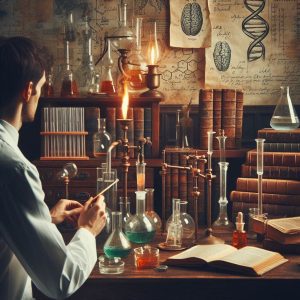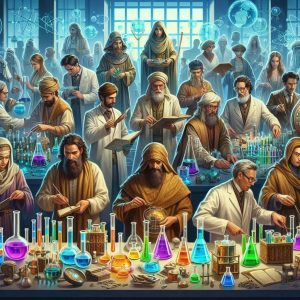History of Biochemistry
The History of Biochemistry traces back to the 19th century when scientists began to uncover the chemical processes underlying biological functions. This interdisciplinary field combines biology and chemistry to understand the molecular mechanisms that drive life.
Early Foundations in the History of Biochemistry
The early History of Biochemistry saw significant milestones with the discovery of enzymes. In 1833, Anselme Payen and Jean-François Persoz identified diastase, an enzyme that catalyzes the breakdown of starch into sugars. This marked one of the first instances of recognizing biochemical reactions within living organisms.
Friedrich Wöhler’s synthesis of urea in 1828 from ammonium cyanate demonstrated that organic compounds could be synthesized from inorganic materials, challenging the vitalism theory. This experiment was a pivotal moment in the History of Biochemistry, illustrating the chemical nature of biological substances.
The discovery of the role of enzymes in fermentation by Eduard Buchner in 1897 further advanced the field. His work on cell-free fermentation earned him the Nobel Prize in Chemistry in 1907 and provided conclusive evidence that biochemical processes could occur outside living cells.
The Advent of Molecular Biologyin History of Biochemistry
The advent of molecular biology in the mid-20th century marked a pivotal era in the History of Biochemistry. This period was characterized by groundbreaking discoveries that linked biochemical processes with genetic information, fundamentally changing our understanding of life.
A key milestone in this era was the discovery of the DNA double helix structure by James Watson and Francis Crick in 1953, which was based on crucial X-ray diffraction images provided by Rosalind Franklin. This discovery elucidated how genetic information is stored and replicated, laying the foundation for modern genetics and molecular biology.
The elucidation of the central dogma of molecular biology, which describes the flow of genetic information from DNA to RNA to protein, was another critical development. This concept, proposed by Francis Crick, highlighted the processes of transcription and translation, explaining how genes dictate the synthesis of proteins, which perform various functions in the cell.
The advent of techniques such as X-ray crystallography and electron microscopy allowed scientists to determine the three-dimensional structures of biological macromolecules. These techniques were pivotal in revealing the detailed architecture of proteins, nucleic acids, and other biomolecules, providing insights into their function and interactions.
Another significant breakthrough was the development of recombinant DNA technology in the 1970s, pioneered by scientists like Herbert Boyer and Stanley Cohen. This technology enabled the manipulation and cloning of DNA sequences, revolutionizing biotechnology and paving the way for genetic engineering, gene therapy, and synthetic biology.

Key Discoveries in the History of Biochemistry
Several key discoveries have shaped the History of Biochemistry:
- Enzyme Catalysis: In 1897, Eduard Buchner demonstrated that fermentation could occur in a cell-free yeast extract, proving that biochemical reactions could occur outside living cells. This discovery earned him the Nobel Prize in Chemistry in 1907.
- Metabolic Pathways: The elucidation of metabolic pathways, such as glycolysis by Gustav Embden, Otto Meyerhof, and Jakub Karol Parnas, and the citric acid cycle by Hans Krebs, was crucial in understanding cellular respiration and energy production. Hans Krebs received the Nobel Prize in Physiology or Medicine in 1953 for his work on the citric acid cycle.
- Protein Structure: Determining the three-dimensional structures of proteins using X-ray crystallography was a monumental achievement. Max Perutz and John Kendrew’s work on the structures of hemoglobin and myoglobin earned them the Nobel Prize in Chemistry in 1962, paving the way for understanding protein function and interactions at the molecular level.
- DNA Structure: The discovery of the double helix structure of DNA by James Watson and Francis Crick in 1953, based on Rosalind Franklin’s critical X-ray diffraction images, revolutionized the field of genetics. This discovery provided insights into how genetic information is stored and replicated, fundamentally changing our understanding of biology.
- Central Dogma of Molecular Biology: Francis Crick’s proposal of the central dogma, which describes the flow of genetic information from DNA to RNA to protein, was a key conceptual framework that linked biochemistry and genetics. This understanding has been pivotal in studying gene expression and regulation.
| Year | Discovery | Impact |
|---|---|---|
| 1833 | Discovery of Diastase | First enzyme identified, foundation for enzyme chemistry |
| 1897 | Cell-Free Fermentation | Proof that biochemical reactions can occur outside living cells |
| 1953 | Structure of DNA | Revolutionized understanding of genetics and heredity |
| 1962 | Protein Structures (Hemoglobin, Myoglobin) | Advanced knowledge of protein function and structure |
Modern Biochemistry and Its Applications
Today, the field of biochemistry continues to evolve, driving advancements in medicine, biotechnology, and environmental science. Applications range from drug development to genetic engineering. The History of Biochemistry has paved the way for modern techniques such as CRISPR-Cas9 for gene editing, which holds promise for treating genetic disorders and enhancing crop resilience.
Timeline of Major Milestones in the History of Biochemistry
| Year | Discovery/Development | Impact |
|---|---|---|
| 1833 | Discovery of Diastase | First enzyme identified, foundation for enzyme chemistry |
| 1897 | Cell-Free Fermentation | Proof that biochemical reactions can occur outside living cells |
| 1953 | Structure of DNA | Revolutionized understanding of genetics and heredity |
| 1962 | Protein Structures (Hemoglobin, Myoglobin) | Advanced knowledge of protein function and structure |

Future Directions in Biochemistry
The future of biochemistry promises exciting developments, particularly in personalized medicine, synthetic biology, and bioinformatics in History of Biochemistry. Personalized medicine aims to tailor treatments based on an individual’s genetic profile, enhancing the efficacy and safety of therapies. Synthetic biology involves designing and constructing new biological parts and systems, which could lead to breakthroughs in biotechnology and medicine.
Advances in bioinformatics are transforming how researchers analyze and interpret vast amounts of biological data. This field combines biology, computer science, and information technology to understand and predict biological functions and interactions. The integration of machine learning and artificial intelligence in bioinformatics is expected to accelerate discoveries in biochemistry further.
One of the most promising areas in biochemistry is the development of new drug delivery systems. Researchers are exploring nanotechnology to create targeted drug delivery mechanisms that can deliver therapeutic agents directly to diseased cells, minimizing side effects and improving treatment outcomes.
Environmental biochemistry is another emerging field, focusing on understanding and mitigating the effects of pollutants
FAQs About the History of Biochemistry
What is biochemistry?

Biochemistry is the study of the chemical processes and substances that occur within living organisms. It involves the exploration of proteins, lipids, carbohydrates, and nucleic acids, which are the fundamental molecules of life.
How did biochemistry originate?
Biochemistry originated in the 19th century as scientists began to understand that biological processes could be explained by chemistry. Early experiments by pioneers like Louis Pasteur and Friedrich Wöhler laid the groundwork for the field, demonstrating that chemical reactions were fundamental to biological processes.
What were some key milestones in the history of biochemistry?
Key milestones include the discovery of enzymes by Eduard Buchner in 1897, the identification of DNA as the genetic material by Avery, MacLeod, and McCarty in 1944, and the elucidation of the double-helix structure of DNA by Watson and Crick in 1953. These discoveries have profoundly influenced our understanding of biology and medicine.
How has biochemistry impacted medicine?
Biochemistry has significantly impacted medicine by providing insights into the molecular basis of diseases, leading to the development of diagnostic techniques, therapies, and vaccines. Understanding biochemical pathways has enabled the development of targeted treatments for various conditions, including cancer, diabetes, and genetic disorders.
What are some current trends in biochemistry research?
Current trends in biochemistry research include the study of genomics, proteomics, and metabolomics, which involve the comprehensive analysis of genes, proteins, and metabolites. Advances in technology, such as CRISPR gene editing and high-throughput sequencing, are driving new discoveries and applications in biochemistry.
Disclaimer
The information provided in this FAQ section is intended for educational purposes only. While efforts have been made to ensure the accuracy of the content, it should not be used as a substitute for professional advice or scientific research. Readers are encouraged to consult authoritative sources and experts in the field of biochemistry for more detailed information. I mentioned again, that the information provided in this article is for educational purposes only and is not intended as a substitute for professional advice or scientific research.
Caution
When conducting biochemical research or experiments, it is important to follow ethical guidelines and safety protocols. Laboratory work should be performed with proper training and supervision to avoid risks associated with chemicals and biological materials. Always adhere to local regulations and international standards to ensure safe and responsible scientific practices.



